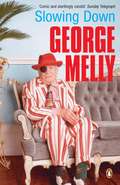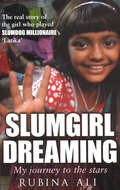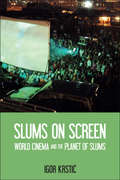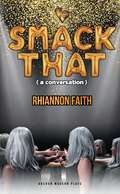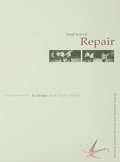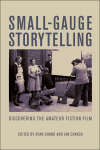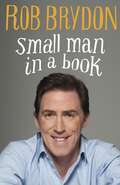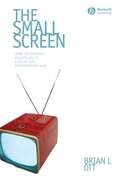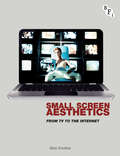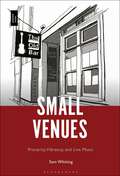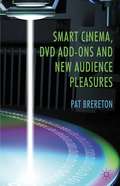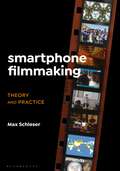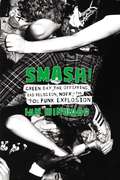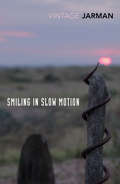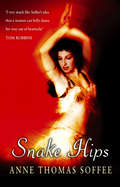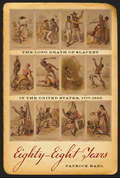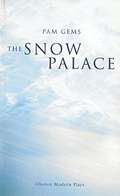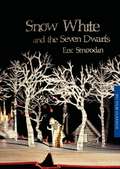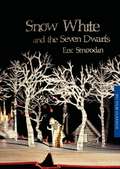- Table View
- List View
Slowing Down
by George MellyGeorge Melly is 79 nudging 80. You'll probably think, 'That's not old these days'. And it's true, George is still swinging and singing, fly-fishing, flirting, and for now just playing at senility. But it's not as if he were the Queen Mother. He walks very slowly nowadays. He's losing control over his bladder, and his bowels. He no longer, being quite deaf, enjoys noisy parties. He's been seriously ill once, and not quite well often. And he's constantly being probed and tinkered with at St Mary's Hospital: like an old car in and out of the garage. Sex has walked out on him, but Irish Whiskey, in only slightly diminished quantities, remains a good friend. This remarkably cheerful book is his diary of it all. An extraordinary, darkly funny, frank, and larger-than-life account about how feels to be growing old and irresistibly Slowing Down.
Slumgirl Dreaming: My Journey to the Stars
by Rubina AliMy name is Rubina Ali. I don't know when my birthday is, and nor does my father, but I do know that I am nine years old.Rubina is a one-in-a-million-star. After being plucked from among the five-hundred slum children who auditioned for Danny Boyle's multi-Oscar-winning film SLUMDOG MILLIONAIRE, she saw her fairytale dream of stardom come true. But what does the future hold for a little girl now trapped between Hollywood glamour and the bleak poverty of her Mumbai slum?Now she tells her own incredible story, from playing marbles with her friends beside the sewers of Garib Nagar , to dancing along to the Bollywood films she and her family watch on their old television set. Rubina brings alive a world of wastelands and rat-infested shanty dwellings, and shows us her home near the raliway line where she lives with her beloved father and siblings. She tells us how her co-star came to be covered head to toe in chocolate, and how she came to meet a tall pale lady named Nicole Kidman. But how has this little girl's intimate world changed since Hollywood came knocking? And what will happen to her next?Royalties from this book will be shared with the author and Medecins du Monde in India.
Slums on Screen: World Cinema and the Planet of Slums
by Igor KrstićNear to one billion people call slums their home, making it a reasonable claim to describe our world as a ‘planet of slums.’ But how has this hard and unyielding way of life been depicted on screen? How have filmmakers engaged historically and across the globe with the social conditions of what is often perceived as the world’s most miserable habitats? Combining approaches from cultural, globalisation and film studies, Igor Krstic outlines a transnational history of films that either document or fictionalise the favelas, shantytowns, barrios poulares or chawls of our ‘planet of slums’, exploring the way accelerated urbanisation has intersected with an increasingly interconnected global film culture. From Jacob Riis’ How The Other Half Lives (1890) to Danny Boyle’s Slumdog Millionaire (2008), the volume provides a number of close readings of films from different historical periods and regions to outline how contemporary film and media practices relate to their past predeccesors, demonstrating the way various filmmakers, both north and south of the equator, have repeatedly grappled with, rejected or continuously modified documentary and realist modes to convey life in our ‘planet of slums’.
Smack That (Oberon Modern Plays)
by Rhiannon FaithEndlessly inventive dance theatre artist Rhiannon Faith shines a light on the complex subject of domestic abuse in an empowering and participatory performance highlighting human resilience. Beverly is having a party and you are her guest. Both performers and non-performers come together to tell their real stories of domestic abuse in a unique, turbulent and empowering way. Shameless and subversive dance theatre about human resilience, survival and how we care for one another. Expect games, dancing, humour and a very raw and honest account of domestic abuse. Each member of the all-female cast, a close-knit group of nonperformers and dance artists, fearlessly takes on the persona of Beverly to convey turbulent, real experiences. Faith’s work with a support group at charity Safer Places underpins this show, which seeks to raise social consciousness around domestic abuse by supporting women to openly talk about it. Includes forewords by Bryony Kimmings (Performance Artist) and Joanne Majauskis (Safer Places).
Small Acts of Repair: Performance, Ecology and Goat Island
by Stephen Bottoms Matthew GoulishGoat Island are one of the world’s leading contemporary performance ensembles. Their intimate, low-tech, intensely physical performances represent a unique hybrid of strategies and techniques drawn from live art, experimental theatre and postmodern dance. Small Acts of Repair: Performance, Ecology and Goat Island, is the first book to document and critique the company’s performances, processes, politics, aesthetics, and philosophies. It reflects on the company’s work through the critical lens of ecology – an emerging and urgent concern in performance studies and elsewhere. This collage text combines and juxtaposes writing by company members and arts commentators, to look in detail at Goat Island’s distinctive collaborative processes and the reception of their work in performance. The book includes a section of practical workshop exercises and thoughts on teaching drawn from the company’s extensive experience, providing an invaluable classroom resource. By documenting the creative processes of this extraordinary company, this book will make an important contribution to the critical debates surrounding contemporary performance practices. In so doing, it pays compelling tribute to committed art-making, creativity, collaboration, and the nature of the possible.
Small Acts of Repair: Performance, Ecology and Goat Island
by Stephen Bottoms Matthew GoulishGoat Island are one of the world’s leading contemporary performance ensembles. Their intimate, low-tech, intensely physical performances represent a unique hybrid of strategies and techniques drawn from live art, experimental theatre and postmodern dance. Small Acts of Repair: Performance, Ecology and Goat Island, is the first book to document and critique the company’s performances, processes, politics, aesthetics, and philosophies. It reflects on the company’s work through the critical lens of ecology – an emerging and urgent concern in performance studies and elsewhere. This collage text combines and juxtaposes writing by company members and arts commentators, to look in detail at Goat Island’s distinctive collaborative processes and the reception of their work in performance. The book includes a section of practical workshop exercises and thoughts on teaching drawn from the company’s extensive experience, providing an invaluable classroom resource. By documenting the creative processes of this extraordinary company, this book will make an important contribution to the critical debates surrounding contemporary performance practices. In so doing, it pays compelling tribute to committed art-making, creativity, collaboration, and the nature of the possible.
Small Cinemas of the Andes: New Aesthetics, Practices and Platforms
by Diana Coryat Christian León Noah ZweigThis book examines the emergence of small cinemas of the Andes, covering digital peripheries in Ecuador, Bolivia, Peru and Colombia. The volume critically assesses heterogeneous audiovisual practices and subaltern agents, elucidating existing tensions, contradictions and resistances with respect to established cinematic norms. The reason these small cinematic sectors are of interest is twofold: first, the film markets of the aforementioned countries are often eclipsed by the filmmaking giants of Mexico, Brazil and Argentina; second, within the Andean countries these small cinemas are overshadowed by film board-backed cinemas whose products are largely designed for international film festivals.
Small-Gauge Storytelling: Discovering the Amateur Fiction Film
by Ryan Shand Ian CravenThis book focuses on amateur fiction film-making
Small Man in a Book
by Rob BrydonRob Brydon tells story of his slow ascent to fame and fortune in Small Man in a Book.A multi-award-winning actor, writer, comedian and presenter known for his warmth, humour and inspired impressions, Rob Brydon has quickly become one of our very favourite entertainers. But there was a time when it looked like all we'd hear of Rob was his gifted voice.Growing up in South Wales, Rob had a passion for radio and soon the Welsh airwaves resounded to his hearty burr. However, these were followed by years of misadventure and struggle, before, in the TV series Marion and Geoff and Gavin and Stacey, Rob at last tickled the nation's funny bone. The rest, as they say, is history. Or in his case autobiography.Small Man in a Book is Rob Brydon's funny, heartfelt, honest, sometimes sad, but mainly funny, memoir of how a young man from Wales very, very slowly became an overnight success.Rob Brydon was brought up in Wales, where his career began on radio and as a voiceover artist. After a brief stint working for the Home Shopping Network he co-wrote and performed in his breakthrough show, the darkly funny Human Remains. He has since starred in the immensely popular Gavin and Stacey, Steve Coogan's partner in The Trip, and was the host of Would I Lie to You? and The Rob Brydon Show. He now lives in London with his wife and five children.
The Small Screen: How Television Equips Us to Live in the Information Age
by Brian L. OttTelevision is one of the most important socializing forces in contemporary culture. This book is a cultural history of prime-time television in America during the 1990s. Examines changes that took place in programming, such as the rapid adoption of cable, the proliferation of content providers, the development of niche marketing, the introduction of high-definition television, the blurring of traditional genres, and the creation of new formats like reality-based programming Argues that television programmes of the 1990s afforded viewers a symbolic resource for negotiating the psychological challenges associated with the shift from the Industrial Age to the Information Age Explores the ways in which television provided viewers with tools for coming to terms with their fears about living in the fast-paced , increasingly diverse, information-laden society of the 90s
Small Screen Aesthetics: From Television to the Internet
by NA NAThis new study provides an introduction to TV aesthetics and viewership from the 1940s to the present day, at a time when television as a medium is 'converging' with the pc and laptop.
Small Venues: Precarity, Vibrancy and Live Music
by Sam WhitingThroughout the history of popular music, the careers of many culturally significant artists and groups began on the small stages of local bars clubs, pubs, and discotheques. When the stories of The Beatles, Jimi Hendrix, and the New York punk hardcore and post punk scenes are told, iconic venues such as The Cavern, The Marquee and CBGB's serve as the settings of their early chapters Small live music venues such as these are pivotal in the narratives and history of popular music. However, very few of them survive. This book focusses on the role of small live music venues as incubators for emerging talent and social hubs for music scene participants. Such venues are grassroots spaces of cultural labor and production that often struggle with issues of financial precarity yet are fundamental to the live music ecology of a city, acting both as platforms for emergent performers and spaces of sociality for local music scenes.
Small Venues: Precarity, Vibrancy and Live Music
by Sam WhitingThroughout the history of popular music, the careers of many culturally significant artists and groups began on the small stages of local bars clubs, pubs, and discotheques. When the stories of The Beatles, Jimi Hendrix, and the New York punk hardcore and post punk scenes are told, iconic venues such as The Cavern, The Marquee and CBGB's serve as the settings of their early chapters Small live music venues such as these are pivotal in the narratives and history of popular music. However, very few of them survive. This book focusses on the role of small live music venues as incubators for emerging talent and social hubs for music scene participants. Such venues are grassroots spaces of cultural labor and production that often struggle with issues of financial precarity yet are fundamental to the live music ecology of a city, acting both as platforms for emergent performers and spaces of sociality for local music scenes.
Smart Cinema, DVD Add-Ons and New Audience Pleasures
by P. BreretonExamining post-1990s Indie cinema alongside more mainstream films, Brereton explores the emergence of smart independent sensibility and how films break the classic linear narratives that have defined Hollywood and its alternative 'art' cinema. The work explores how bonus features on contemporary smart films speak to new generational audiences.
Smartphone Filmmaking: Theory and Practice
by Max SchleserMobile, smartphone and pocket filmmaking is a global phenomenon with distinctive festivals, filmmakers and creatives that are defining an original film form. Smartphone Filmmaking: Theory and Practice explores diverse approaches towards smartphone filmmaking and interviews an overview of the international smartphone filmmaking community. Interviews with smartphone filmmakers, entrepreneurs, creative technologists, storytellers, educators and smartphone film festival directors provide a source of inspiration and insights for professionals, emerging filmmakers and rookies who would like to join this creative community. While not every story might be appropriate to be realized with a mobile device or smartphone, if working with communities, capturing locations or working in the domain of personal or first-person filmmaking, the smartphone or mobile device should be considered as the camera of choice. The mobile specificity is expressed through accessibility, mobility and its intimate and immediate qualities. These smartphone filmmaking-specific characteristics and personal forms of crafting experiences contribute to a formation of new storytelling approaches. Stylistic developments of vertical video and collaborative processes in smartphone filmmaking are evolving into hybrid formats that resonate in other film forms.This book not only develops a framework for the analysis of smartphone filmmaking but also reviews contemporary scholarship and directions within the creative arts and the creative industries. Smartphone Filmmaking: Theory and Practice initiates a conversation on current trends and discusses its impact on adjacent disciplines and recent developments in emerging media and screen production, such as Mobile XR (extended reality).
Smartphone Filmmaking: Theory and Practice
by Max SchleserMobile, smartphone and pocket filmmaking is a global phenomenon with distinctive festivals, filmmakers and creatives that are defining an original film form. Smartphone Filmmaking: Theory and Practice explores diverse approaches towards smartphone filmmaking and interviews an overview of the international smartphone filmmaking community. Interviews with smartphone filmmakers, entrepreneurs, creative technologists, storytellers, educators and smartphone film festival directors provide a source of inspiration and insights for professionals, emerging filmmakers and rookies who would like to join this creative community. While not every story might be appropriate to be realized with a mobile device or smartphone, if working with communities, capturing locations or working in the domain of personal or first-person filmmaking, the smartphone or mobile device should be considered as the camera of choice. The mobile specificity is expressed through accessibility, mobility and its intimate and immediate qualities. These smartphone filmmaking-specific characteristics and personal forms of crafting experiences contribute to a formation of new storytelling approaches. Stylistic developments of vertical video and collaborative processes in smartphone filmmaking are evolving into hybrid formats that resonate in other film forms.This book not only develops a framework for the analysis of smartphone filmmaking but also reviews contemporary scholarship and directions within the creative arts and the creative industries. Smartphone Filmmaking: Theory and Practice initiates a conversation on current trends and discusses its impact on adjacent disciplines and recent developments in emerging media and screen production, such as Mobile XR (extended reality).
Smash!: Green Day, The Offspring, Bad Religion, NOFX, and the '90s Punk Explosion
by Ian WinwoodA group biography of '90s punk rock told through the prism of Green Day, The Offspring, NOFX, Rancid, Bad Religion, Social Distortion, and moreTwo decades after the Sex Pistols and the Ramones birthed punk music into the world, their artistic heirs burst onto the scene and changed the genre forever. While the punk originators remained underground favorites and were slow burns commercially, their heirs shattered commercial expectations for the genre. In 1994, Green Day and The Offspring each released their third albums, and the results were astounding. Green Day's Dookie went on to sell more than 15 million copies and The Offspring's Smash remains the all-time bestselling album released on an independent label. The times had changed, and so had the music.While many books, articles, and documentaries focus on the rise of punk in the '70s, few spend any substantial time on its resurgence in the '90s. Smash! is the first to do so, detailing the circumstances surrounding the shift in '90s music culture away from grunge and legitimizing what many first-generation punks regard as post-punk, new wave, and generally anything but true punk music.With astounding access to all the key players of the time, including members of Green Day, The Offspring, NOFX, Rancid, Bad Religion, Social Distortion, and many others, renowned music writer Ian Winwood at last gives this significant, substantive, and compelling story its due. Punk rock bands were never truly successful or indeed truly famous, and that was that--until it wasn't. Smash! is the story of how the underdogs finally won and forever altered the landscape of mainstream music.
Smash!: Green Day, The Offspring, Bad Religion, NOFX, and the '90s Punk Explosion
by Ian WinwoodA group biography of '90s punk rock told through the prism of Green Day, The Offspring, NOFX, Rancid, Bad Religion, Social Distortion, and more Two decades after the Sex Pistols and the Ramones birthed punk music into the world, their artistic heirs burst onto the scene and changed the genre forever. While the punk originators remained underground favorites and were slow burns commercially, their heirs shattered commercial expectations for the genre. In 1994, Green Day and The Offspring each released their third albums, and the results were astounding. Green Day's Dookie went on to sell more than 15 million copies and The Offspring's Smash remains the all-time bestselling album released on an independent label. The times had changed, and so had the music. While many books, articles, and documentaries focus on the rise of punk in the '70s, few spend any substantial time on its resurgence in the '90s. Smash! is the first to do so, detailing the circumstances surrounding the shift in '90s music culture away from grunge and legitimizing what many first-generation punks regard as post-punk, new wave, and generally anything but true punk music. With astounding access to all the key players of the time, including members of Green Day, The Offspring, NOFX, Rancid, Bad Religion, Social Distortion, and many others, renowned music writer Ian Winwood at last gives this significant, substantive, and compelling story its due. Punk rock bands were never truly successful or indeed truly famous, and that was that -- until it wasn't. Smash! is the story of how the underdogs finally won and forever altered the landscape of mainstream music.
Smiling in Slow Motion: Diaries, 1991-1994
by Derek Jarman'For days now I have tried to start this diary, but the clatter of my existence has warned me off; the first mark on the page eludes me...'Derek Jarman's Smiling in Slow Motion concludes the journey started in Modern Nature, these previously unpublished journals stretch from May 1991 until a fortnight before his death in February 1994. Part diary, part observation, part memoir, Jarman writes with his familiar honesty, wry humour and acuity. Friends, collaborators and enemies are catalogued as he races through his last year painting, film-making, gardening, and annoying his targets through his involvement in radical politics.Writing from his Charing Cross Road flat, on his visits to international film festivals, his world famous garden at Dungeness in Kent, and finally from his bed in St Bartholomew's Hospital, Jarman illuminates an era which seems more ephemeral and out-of-grasp with each passing day. Smiling in Slow Motion is not a document of illness, regret and resignation, but one of endeavour, remembrance and love.
Snake Hips: Belly Dancing And How I Found True Love
by Anne Thomas SoffeeSNAKE HIPS follows an Arab-American woman's life as she shimmies her way from getting dumped by her tattoo-artist boyfriend to coming to grips with being single, ample, and 30. Her heart broken, Soffee moves back home to wallow in self-pity. There she comes across a flier advertising the usual classes in yoga, vegetarian cookery, ballet and...belly dancing. Against the wishes of her extended family and friends, she enrols, hoping to heal her heart and reconnect with her Lebanese roots. Soffee soon discovers that her life will never be the same after she enters the riotous world of belly dancing, a warm and welcoming subculture where younger and thinner are not necessarily better. Soffee's ethnic high leads to Princess Jasmine fantasies - for example, being 'third-favourite wife' to a sheik she is cyber-dating, a perfect relationship until she realizes that being obedient is easier online. Then she falls for a beautiful Lebanese boy-next-door. Among the zils (finger cymbals) and thrills of performing in moose lodges and county fairs, Soffee is surprised to find happiness and true love along the way.
Snakes and Ladders: Improvisation And The Theatre (Bloomsbury Revelations Ser.)
by Dirk BogardeFirst published in 1978, Snakes and Ladders is volume two of Dirk Bogarde's best-selling memoirsSnakes and Ladders follows Bogarde from the challenges of his army training camp at Catterick, through the horrors of war, to his glittering – if often trying – film career. We see the thoughtful boy finding his way alongside his fellow recruits, to emerge from the war a thoughtful man, shaped in many ways by his harrowing experiences. Somewhat falling into his career, Dirk struggled with the demands that such great success brings with it. With personal insight into his close friendship with Judy Garland, his working method with Visconti, and his many vital relationships with friends and family, Snakes and Ladders sheds an honest and not always flattering light on his life.
The Snow Palace (Modern Plays Series)
by Pam GemsThe Snow Palace is the story of Polish playwright Stanislawa Przybyszewska, a pathfinder and a brave, lonely woman, as she writes her great play The Danton Affair. She died in her thirties of hypothermia in her unheated hut.
Snow White and the Seven Dwarfs (BFI Film Classics)
by Eric SmoodinOn release in the 1930s, Snow White became a milestone in animated film, Disney production and the US box office. Today its fans cross generations and continents, proving that this tale of the loveable, banished princess and her seven outstanding friends possesses a special magic that makes it both an all-time Disney great and a true film classic.
Snow White and the Seven Dwarfs (BFI Film Classics)
by Eric SmoodinOn release in the 1930s, Snow White became a milestone in animated film, Disney production and the US box office. Today its fans cross generations and continents, proving that this tale of the loveable, banished princess and her seven outstanding friends possesses a special magic that makes it both an all-time Disney great and a true film classic.
Snuff (Devil's Advocates)
by Mark McKennaSnuff (1976) occupies a unique place in cinematic history, as the first commercially successful film to capitalise upon the myth of the ‘snuff’ movie. By blending cinema verité styling with a media moral panic, savvy producer Allan Shackleton’s blending of a long-forgotten exploitation film with a newly filmed bloody, if unconvincing conclusion, only served to consolidate the belief that somewhere, at some time, someone was killed on camera in an attack that was as much about the sexual gratification of the film’s intended audience, as it was about the commercial rewards for those producing the film. In the years since its release, the film has been routinely cited as ‘evidence’ of the snuff movie’s existence, contributing to a cultural history that exists outside of the film. This book explores the production, distribution and exhibition of the film Snuff, alongside that cultural history, considering how a scarcely seen exploitation film contributed to a popular understanding of the snuff movie. It assesses the cultural, cinematic and political legacy of the film and asks whether the established definition of what might constitute a snuff movie, that was defined 45 years ago, is sufficient in an attention economy that is based upon participatory culture.
